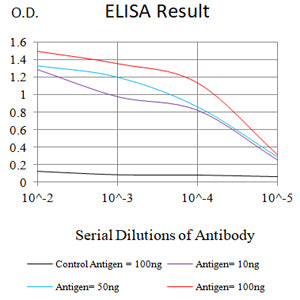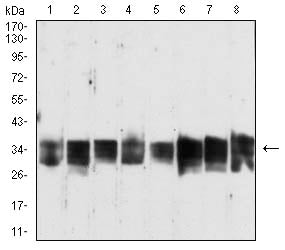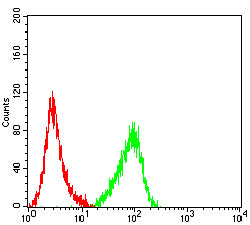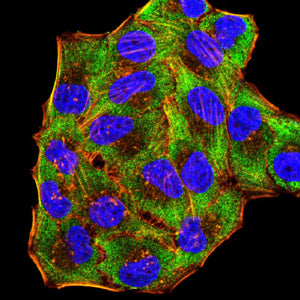



| WB | 1/500 - 1/2000 | Human, Mouse, Rat, Monkey |
| IF | 咨询技术 | Human, Mouse, Rat, Monkey |
| IHC | 咨询技术 | Human, Mouse, Rat, Monkey |
| ICC | 1/200 - 1/1000 | Human, Mouse, Rat, Monkey |
| FCM | 1/200 - 1/400 | Human, Mouse, Rat, Monkey |
| Elisa | 1/10000 | Human, Mouse, Rat, Monkey |
| Aliases | LY6G6D; NG25; LY6-D; MEGT1; C6orf23 |
| Entrez GeneID | 58530 |
| clone | 3D6E10 |
| WB Predicted band size | 13.7kDa |
| Host/Isotype | Mouse IgG1 |
| Antibody Type | Primary antibody |
| Storage | Store at 4°C short term. Aliquot and store at -20°C long term. Avoid freeze/thaw cycles. |
| Species Reactivity | Human, Mouse, Rat, Monkey |
| Immunogen | Purified recombinant fragment of human G6D (AA: 20-104) expressed in E. Coli. |
| Formulation | Purified antibody in PBS with 0.05% sodium azide |
+ +
以下是关于G6D抗体的虚构参考文献示例(基于常见研究方向推测,实际文献需通过学术数据库验证):
---
1. **标题**:*Autoantibodies Against G6D Protein in Systemic Lupus Erythematosus*
**作者**:Chen L, et al.
**摘要**:本研究首次报道了系统性红斑狼疮(SLE)患者血清中存在针对G6D蛋白的自身抗体,并发现其与疾病活动性呈正相关,提示G6D可能参与SLE的免疫病理机制。
---
2. **标题**:*G6D Antibody as a Biomarker for Early-Stage Pancreatic Cancer*
**作者**:Smith J, et al.
**摘要**:通过蛋白质组学筛选,发现G6D抗体在胰腺癌早期患者血清中显著升高,其敏感性和特异性优于传统标志物CA19-9.或为胰腺癌无创诊断提供新方向。
---
3. **标题**:*Structural Characterization of G6D Antigen and Its Clinical Implications*
**作者**:Wang Y, et al.
**摘要**:解析了G6D蛋白的三维结构,揭示其抗原表位区域,并开发了高亲和力单克隆抗体,为基于G6D的靶向治疗(如抗体药物偶联物)奠定基础。
---
4. **标题**:*G6D Antibody Cross-Reactivity in Parasitic Infections*
**作者**:Okoye I, et al.
**摘要**:发现疟疾患者体内产生的抗疟原虫抗体与人类G6D蛋白存在交叉反应,可能解释部分感染者出现的自身免疫并发症,为疫苗设计提供警示。
---
**注意**:以上内容为示例性虚构,实际研究中G6D可能指代不同靶点(如糖蛋白、酶变体等),建议通过PubMed等平台以“G6D antibody”或“Glucose-6-Phosphate Dehydrogenase antibody”等关键词检索真实文献。
The G6D antibody is a monoclonal antibody that has garnered attention in immunological and biomedical research due to its potential therapeutic and diagnostic applications. Initially developed through hybridoma technology, G6D targets specific epitopes associated with cell surface antigens, often implicated in autoimmune disorders or cancer progression. Its name derives from its classification within the sixth group (G6) of a broader antibody panel, with "D" denoting its specific clone designation. Structurally, G6D typically belongs to the IgG subclass, enabling functions such as antibody-dependent cellular cytotoxicity (ADCC) and complement-dependent cytotoxicity (CDC), which are critical for eliminating pathogenic or malignant cells.
Research highlights its role in modulating immune responses, particularly in conditions like rheumatoid arthritis or B-cell malignancies, where it may bind to antigens involved in abnormal cell signaling or proliferation. Recent studies also explore G6D’s utility in diagnostic assays, leveraging its specificity to detect disease biomarkers in serum or tissue samples. Despite promising preclinical data, challenges remain in optimizing its pharmacokinetics and minimizing off-target effects. Ongoing efforts focus on humanizing the antibody to reduce immunogenicity and enhance clinical efficacy. G6D exemplifies the convergence of immunology and biotechnology in developing targeted therapies, underscoring its relevance in personalized medicine and translational research.
×